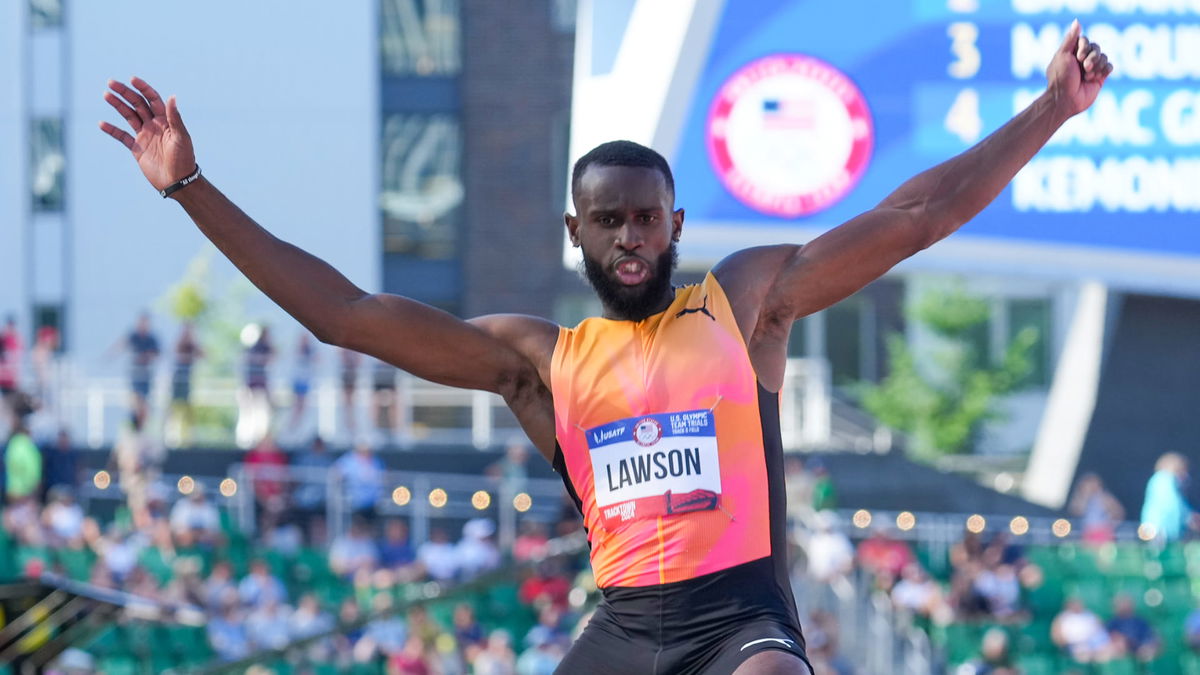

Only a few fortunate achievers get the honor of listening to the synchronizing tone of trumpets and bugles while wrapping themselves in the Stars and Stripes. Jarrion Lawson hasn’t gotten the honor of becoming one of them yet. He has had two of his chances thinning into the air and both times all he had as the leftover was watching him go down, from being the favorite to transforming into the morose.
Watch What’s Trending Now!
In 2016, a certain millimeter on the jumping line felt like a mile for him, giving Lawson fourth position while the top three celebrated the Olympic medals around their neck. Straight back to the Pandemic-affected Tokyo Olympics year, the six-time NCAA champion was nowhere among the athletes at the trials of Hayward Field. Nevertheless, in those days, he had the cushion of being the favorite again. But his fate sang a different tune, and the athlete’s injury cost him a trial and the Olympic berth. But did we mention his 2018 turmoil in the meantime?
The athlete has too many stories and standing in 2024; the man is determined to change his fate.
ADVERTISEMENT
On Monday, Jarrion Lawson qualified for the long jump event for the Paris Olympics. With that, he has inched closer to his dream. Now, after qualifying, Lawson still remembers the days that put a question mark on his career.
Jarrion Lawson touches the ground after jumping 8.18 meters
Monday Blues turned into a moment of celebration for Jarrion Lawson qualified for the Olympics after eight years. However, the athlete remained humble after jumping 8.18 meters and availing his berth in the Paris Olympics squad. In his words, today’s experience came to him as ‘the crème de la crème’. Yet the route to this started from his 2016 Rio Olympics face-up.
ADVERTISEMENT
Arkansas alum Jarrion Lawson comments on making Team USA in the long jump for the Olympic Games in Paris pic.twitter.com/sOwE3Qk7LG
— Arkansas Track & Field (@RazorbackTF) June 25, 2024
Eight years ago, Jarrion Lawson had been dead sure about seeing himself in the top three on the Olympic podium in his long jump event. But in the final, he missed the mark by 0.04 meters to sail through to the top three. Later, in 2021, he faced a bigger challenge. WADA had found him guilty in 2018 after tracing an exogenous anabolic androgenic steroid in his sample. This led to him facing a four-year ban from the AIA. Jarrion, being the fighter he was, did not give up.
ADVERTISEMENT
He kept knocking at the Court of Arbitration for Sport’s door, calling the entire fiasco a turnout from food contamination. The board paid heed to his argument in 2021 and found him not guilty. Despite the respite, just before the US Olympic track and field trials, the Arkansas Razorback pulled his hamstring. This situation even caught his first coach, Travis Geopfert, by surprise. Jarrion found no way of bringing himself out of such a dark pit. Feeling hapless at the happenings, he could only add, “I’ve never had something like this keep me out of competition. Physically I’m usually ready to go, but this time I just wasn’t.”
Nonetheless, after three years, he now has a chance to ensure that he takes the Olympics by storm.
Top Stories
Simone Biles and Jonathan Owens Receive PETA Letter Over Pet Care Concerns

Controversial Crew Chief Finds Fresh Start With 17-Yo NASCAR Team

Footage Surfaces of Puka Nacua’s Brother Samson Slapping Fan After Arrest for Allegedly Stealing Lakers’ Adou Thiero’s SUV

NASCAR Team Owner Demands Charter-Like Deal for Financially Struggling O’Reilly Series

Chiefs QB Patrick Mahomes Loses Faith in Kansas City With Cowboys Decision as FOX Host Calls Out Clark Hunt’s Ownership

Carlos Alcaraz’s Split With Coach Resulted From ‘Major Disagreements’ With His Father

ADVERTISEMENT
The slow but steady path to Olympic qualification
This year, before moving to the final of the long jump event in the trial, Jarrion Lawson did a 7.95-meter jump, a non-dazzling performance compared to the top names. Furthermore, he fell short of the sub-8 meter category, a number that often keeps hopes radiant for those looking for qualification. However, for the former relay sprinter, the hope centered on his unbowed attitude.
The final on Monday (June 24) was one such example. Another incident showcasing Lawson’s grit happened at the Glasgow World Indoor Championship this year. In the preliminary rounds, Olympic champion Miltiadis Tentoglou breathed fire with an 8.15 m jump. His arch-rival Mattia Furlani was not far behind as he dropped the thunderbolt with an 8.10m long jump. However, Lawson kept the American flag high with his 8.06m jump. That had remained his best performance this year before he touched the 8.18m mark. Lawson’s journey, therefore, has been one that displayed his never-say-never attitude. Soon, the Paris Olympics will witness that form of resilience.
ADVERTISEMENT
ADVERTISEMENT
ADVERTISEMENT

